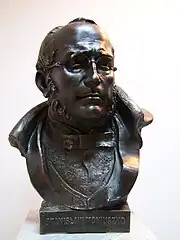Stanisław Moniuszko
Stanisław Moniuszko (Polish pronunciation: [stãˈɲiswaf mɔ̃ˈɲuʃkɔ]; May 5, 1819 – June 4, 1872[1]) was a Polish composer,[2][3] conductor and teacher. He wrote many popular art songs and operas, and his music is filled with patriotic folk themes of the peoples of the former Polish–Lithuanian Commonwealth (mainly Poles, Lithuanians and Belarusians).[4] He is generally referred to as "the father of Polish national opera".[5] Since the 1990s Stanisław Moniuszko is being recognized in Belarus as an important figure to Belarusian culture as well.[6][lower-alpha 1]
.jpg.webp)

Life
Moniuszko was born into a noble landowning family in Ubiel,[8][lower-alpha 2] Minsk Governorate (Russian Empire, now Belarus). His first piano teacher was his mother, Elżbieta (Elizabeth) Madżarska. He later continued his musical education in Warsaw and Minsk,[10] and studied under Carl Friedrich Rungenhagen in Berlin.[3] In 1858 he was appointed conductor at the Warsaw Opera. He also served as a professor at the Warsaw Conservatory.[3] He died in Warsaw in 1872 and was buried at the Powązki Cemetery.[11]
Works

Moniuszko composed more than 300 individual songs, primarily to texts of Polish poets,[12] and around two dozen operas.[10] His series of twelve song books[13] is notable and contains songs to the words of Adam Mickiewicz, Antoni Edward Odyniec, Józef Ignacy Kraszewski, Stefan Witwicki, Antoni Malczewski, and Wincenty Pol.
Moniuszko noted that his songs, which were published under the collective title Śpiewnik Domowy (Domestic Songs), had a national character. Their 'Polishness' is found in his use of and reference to traditional Polish dance rhythms like Polonaise, Mazurka, Kujawiak, and Krakowiak and the propagation of texts written by Polish national poets.[8] The songs were often performed by the 19th-century Polish choirs in Austria, Germany, and Russia,[13] and became a point of reference for other Polish composers.[2] Moniuszko's opera style bears similarities to that of Daniel Auber and Gioachino Rossini, but with stronger emphasis on chorus and melodies inspired by Polish dances.[2] Lithuanians stress, that Stanisław Moniuszko was eagerly using Lithuanian motifs – e.g. his cantatas "Milda", "Nijolė", based on Lithuanian mythology, were issued in Vilnius.[14]
Halka is an opera to a libretto written by Włodzimierz Wolski, a young Warsaw poet with radical social views.[15] After being staged in Warsaw in 1858, it became the most widely known Polish opera[10] and is part of the canon of Polish national operas.
Modern performances
An English version of Straszny dwór (The Haunted Manor, or The Haunted Castle[16]) was created and premiered by the student operatic society at Bristol University in 1970; this version has been performed since, specifically in 2001 by Opera South, which company also presented the world premiere of a specially created new English version of Verbum Nobile in 2002.
In 2008, Pocket Opera, of San Francisco, CA, USA, premiered Artistic Director Donald Pippin's English language translation of The Haunted Manor.
Moniuszko's opera Flis (The Raftsman) was performed and recorded in the Grand Theatre of Polish National Opera at the 2019 Chopin and his Europe International Music Festival, marking the 200th anniversary of Moniuszko's birth.[17]
Paria was performed at Poznań Opera in June 2019, directed by Graham Vick and conducted by Gabriel Chmura.
Moniuszko's operas are regularly performed at the Belarusian National Opera.
Notes
References
- Prosnak 1980, pp. 15, 173.
- Samson, Jim, ed. (2001). The Cambridge History of Nineteenth-Century Music. Cambridge University Press. p. 718. ISBN 978-0521590174.
- Jones, Barrie, ed. (1999). The Hutchinson Concise Dictionary of Music. Routledge. p. 424. ISBN 978-1579581787.
- Аляксей Хадыка [Alexey Khadyka] (May 22, 2009). "Станіслаў Манюшка — паляк, літвін..." [Stanislaw Moniuszko – Pole and Lithuanian] (in Belarusian). Archived from the original on July 27, 2011. Retrieved January 20, 2013. NovyChas.org, Culture. Retrieved from the Internet Archive, February 18, 2013.
- "Stanisław Moniuszko – Ojciec polskiej opery". poland.us.
- "Праправнучка Станислава Монюшко: 'В Минске должен появиться памятник композитору' " [Great-great-granddaughter of Stanisław Moniuszko: 'A monument to the composer should appear in Minsk'] by Кастусь Лашкевич [Kastus Lashkevich], 19 Oktober 2009, Tut.By (in Belarusian)
- Stanisław Moniuszko Museum, Belarus
- Murphy, Michael (2001). "Moniuszko and Musical Nationalism in Poland". In White, Harry; Murphy, Michael (eds.). Musical Constructions of Nationalism: Essays on the History and Ideology of European Musical Culture 1800-1945. Cork University Press. pp. 166–167. ISBN 9781859181539.
- Prosnak, Jan (1980). Moniuszko. Polskie Wydawnictwo Muzyczne. p. 7. ISBN 8322400012.
- Balthazar, Scott L. (2013). Historical Dictionary of Opera. Scarecrow Press. pp. 226–227. ISBN 978-0810867680.
- Prosnak 1980, p. 174.
- Chrenkoff, Magdalena (2017). "Stanisław Moniuszko's Oeuvre as a Builder of National Identity During Partition Times". In Povilionienė, Rima (ed.). Sounds, Societies, Significations: Numanistic Approaches to Music. Springer. p. 61. ISBN 978-3319836522.
- Grazia, Donna M. Di, ed. (2012). Nineteenth-Century Choral Music. Routledge. p. 384. ISBN 978-0415988537.
- STANISLAVAS MONIUŠKA (STANISŁAW MONIUSZKO)
- Murphy 2001, p. 168.
- "Opera: Moniuszko's Haunted Castle"; by Bernard Holland, The New York Times, April 23, 1986
- "Festiwal "Chopin i jego Europa"" [Chopin and his Europe]. Fryderyk Chopin Institute (in Polish). 2019. Retrieved August 13, 2020.
External links
- Free scores by Stanisław Moniuszko at the International Music Score Library Project (IMSLP)
- Free scores by Stanisław Moniuszko in the Choral Public Domain Library (ChoralWiki)
- List of works, lieder.net
- "Stanisław Moniuszko", biography, list of works, Polish Music Center, University of Southern California
- How Family Shaped the Father of Polish Opera
- The Lesser Known Faces of Stanisław Moniuszko
- Sound examples and discussion of String Quartet No. 1 and No. 2, editionsilvertrust.com
- Collection of works by Stanisław Moniuszko in National Digital Library of Poland (Polona)
- Stanislaw Moniuszko. Musical Romantic from Minsk Region to the 200th anniversary of his birth
- Works by Stanislaw Moniuszko on the Belarusian stage